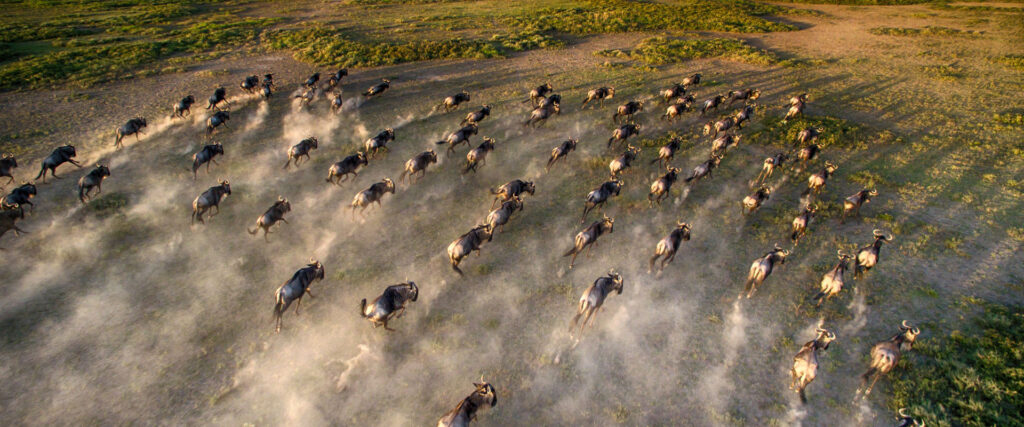
The Great Migration in the Serengeti National Park is an impressive spectacle that repeats more of several hundred years and annually attracts many people to East Africa. Some hundred thousands of antelopes and zebras gather in huge flocks, beginning their way towards the valleys with new grass. Many of them die while crossing: one of them is eaten by predators, others are trampled by their frightened relatives, and some of them simply do not stand such big loads and separate from its herd.
It is a real struggle for life showing all severity and savagery of the animal world of Africa.
Many of travelers want to see The Great Migration of wildebeests and therefore we are going to say about seasons and give some recommendations.
It is worth to note that Great Migration in the Serengeti National Park takes place all year and because of its big size it is possible to meet herds of wildebeests in different parts of the park. Everything depends of the rainy season.
Migration seasons of antelopes
NOVEMBER – JANUARY
The migration cycling in the Serengeti National Park begins exactly in this period when animals move from Kenyan the Maasai Mara National Reserve to the south-east part of the Serengeti, at the border with the crater of Ngorongoro volcano. At this time there is a dry season in Tanzania and approximately 1, 7 million of antelopes, accompanied by 260 000 of zebras and 470 000 gazelles, move to the valley covered with short grass. These two months are the peak in fertility for zebras.
FEBRUARY – MARCH
In February the migration passes in generally in the south part of the Serengeti National Park and in the Ngorongoro Conservation Area. This period is the peak in fertility for antelopes. Big herds with calves are moving around savannah chased by predators. Unfortunately, this crossing is too hard for many yang antelopes and they become victims of predators and scavengers who follow herds on their footsteps.
By early March the fodder near the Ngorongoro disappears and antelopes have to migrate to the western part of the Serengeti, to the region of the Grumeti River.
APRIL
The big herds of animals move to the central part of the park named Seronera. This period is the rainy season in Tanzania. Heavy and prolonged rainfalls give animals many tens of thousands of square kilometers of fresh grass for their nutrition.
MAY – JUNE
This is the end of the rainy season. Herds of antelopes continue to move to the west, to the region named Western Corridor. On their way they overcome Mbalageti and Grumeti Rivers. In this period the famous channels National Geographic and Discovery organize expeditions to the Serengeti to film amazing shots about the overcoming of deep rivers with crocodiles for which the migration is a real feast.
JULY
It is the beginning of the dry season in Tanzania. There are no rains and animals continue to move to the north, towards the border with Kenya along the Grumeti region. In the end of August this amazing cycling of animals reaches the borders of monitoring areas of Ikorongo where is the famous German Fort Ikoma, described in Bernard Grzimek’s book “Serengeti shell not die”.
AUGUST – OCTOBER
In the end of September, the migration reaches borders with Kenya. In October, during the peak of the dry season, most of animals migrate to the Maasai Mara National Reserve where there are a lot of fresh water and the fodder.
Airport pickup and drop off.
Park fees (for non-residents)
all activities (unless labeled as optional)
6-hrs of full game drives in a day with no limitation on where to go in the park.
All accommodations including 1-night on arrivals and 1-night after safaris (unless listed as upgrade)
All Camping equipment.
A professional driver/guide
All transportation (unless labeled as optional)
All Taxes/VAT
All Meals (3 meals a day)- Meals (as specified in the day-by-day section)
Roundtrip airport transfer
Drinking water and Wine during dinner.
Drinking water (on all days)
International flights (from/to home)
Tips (tipping guideline US$15.00 for a driver per day and $10USD per person to a cook per day)
Personal items (souvenirs, travel insurance, visa fees, etc.)
Government imposed increase of taxes and/or park fees